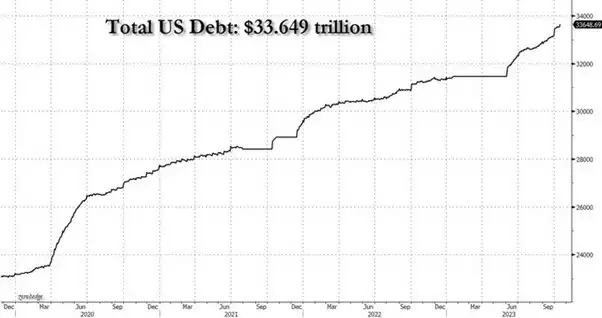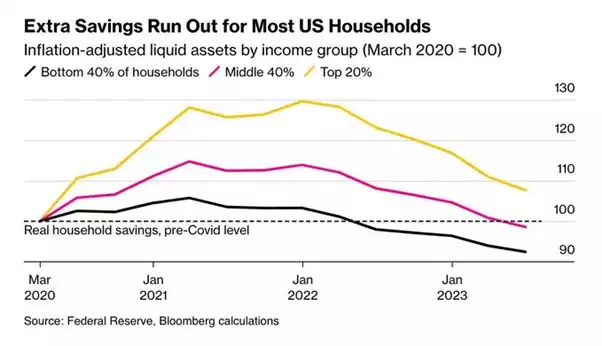Be Fearful of “Soft Landing” Narrative – Pomp
News
|
Posted 23/10/2023
|
2629
Warren Buffet famously said “Be Fearful When Others Are Greedy and Greedy When Others Are Fearful”. It’s a timely observation around human and market psychology and the value in being a contrarian investor. We are at a juncture in markets where the so called ‘soft landing’ narrative, the miraculous ability for the US Fed to somehow not crash the US into a recession through their ‘higher for longer’ approach has plenty of traction despite the backdrop of record high debt and softening fundamentals. The problem is, the math doesn’t support that soft landing and gold is most certainly grabbing the bid from the contrarians with gusto right now. Gold is saying very clearly that now is the time to be fearful.
Highly respected investor and entrepreneur Anthony Pompliano publishes his regular PompLetter to over 250,000 people and this latest tweet is worthy of repeating verbatim as a reminder of the Buffet truism and the hopelessness of the aforementioned ‘math’….
“The national debt has increased by more than $600 billion in the last month. That is $20 billion every day or $833 million every hour. We are now at a total of $33.65 trillion. It is hard to wrap our heads around how insane this pace has become.
Unfortunately, there is no end in sight.

At the same time as the debt is exploding higher, the US economy is showing signs of an incoming recession. Take the inverted yield curve as an example — short-term Treasury yields are higher than long-term Treasury yields.

Over the last 55 years, every inversion between the 3-month and 10-year yield curve was followed by a recession. The shortest lag between inversion and the recession was 3 months and the longest lag was 15 months.
But an economic indicator like yield curve inversion seems to be at odds with the public narrative that a soft landing will be possible, right? Well, Bloomberg recently did a study that showed a rapid increase in articles talking about a soft landing was usually followed by a recession.

You can see the large spike in recent articles mentioning a soft landing would suggest that a recession is incoming. Humans are optimistic and like to think that bad things are not on the horizon, but this study shows that we should be fearful when others are not.
Anna Wong and Tom Orlik have also pointed out that American household’s savings is beginning to run out. This savings had drastically increased during the quantitative easing period related to the pandemic, but households can only hold on for so long before the money starts to run dry. [We wrote to this in more detail here].

To recap, we have yield curves inverting, a spike in soft landing articles, and households running out of money — what is the Fed going to do?
The answer is easy: If we enter a recession, the Fed will be forced to cut interest rates and print money.
Herein lies the problem. The national debt has been growing at a rapid pace, so any additional money printing would only compound the problem. Without this acceleration in debt accumulation, we are on pace to hit $41 trillion by simply extrapolating the last month’s growth rate for the next 12 months.
The number gets even more concerning if the Fed is forced to combat a recession in the US economy.
As if that situation is not difficult enough to navigate, the Fed is not operating in a vacuum of economic data. The United States is also providing monetary support to two international conflicts in Ukraine and Israel to the tune of hundreds of billions of dollars. Each of those wars does not appear to have a clear objective or end date, so we run the risk of new forever wars putting a financial strain on an already bleak US financial health outlook.
Lastly, the United States is going to be faced with hard decisions domestically as well. The southern border has become porous and there are reports that hundreds of thousands of migrants are crossing the border each month. These individuals, who are mostly seeking a better life provided by the democratic and capitalist society of America, are arriving in cities that are ill-equipped to properly support them, which has led to a series of calls from local and state leaders for more federal aid.
This obviously adds to the financial strain on the national financial situation and accelerates the national debt issue.
There are many people who will argue that the national debt does not matter. We are the controllers of the global reserve currency and we can print money whenever we want. My response is always the same, “if the national debt doesn’t matter, then we should print $500 trillion tomorrow and solve all of our problems!” If you think we could do that and there would be no problems, I am very worried for you.
The national debt does matter. We will eventually pay for our sins if we do not get this situation under control. The US dollar can’t hold its value while the debt continues to accelerate at such an incredible pace. At some point, the US may face the nearly impossible decision—save our allies or save our country?
I don’t have all the answers. This situation is very complex. I don’t envy the position of our leaders. There is no known solution on the monetary policy side that can address each problem we are facing, but monetary policy discipline would be a good step in the right direction. The concept of a balanced budget feels impossible in the United States given the current situation, but we had one less than 25 years ago—there is no reason why the right leadership team could not bring us back to that position of strength.”
It is the inevitable response of the US Fed and central banks around the world to flood the market with liquidity via more freshly printed currency and lower rates that is so incredibly supportive of this next gold bull run just as we explained here.